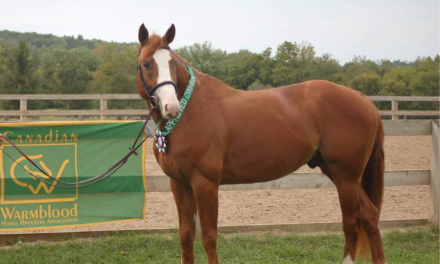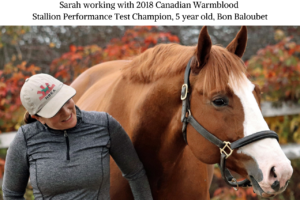We may earn money or products from the companies mentioned in this post. For more information please check out our disclosure page



You may have read my first blog about Jazz the one eyed mare and how she came to be with me. If not you can catch up on reading about her here and learn about her story.
Jazz is a registered 5 year old KWPN mare who came from a reputable breeder in PEI at the end of May 2019. Jazz was born with only one eye.
When she came to me she had been exposed to some minimal handling and had lived life as a part of a broodmare herd. Given her age this meant she had established a true herd mentality and had very little knowledge of what it meant to connect with a human.
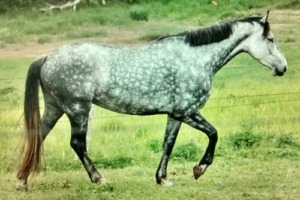
.
One of the first training obstacles we faced was catching her in her stall and in her paddock. She was so terrified of human contact she cowered and tried to hide in the corner of her stall, turning her back to us.
Until she was able to be haltered in the stall and led safely, I wasn’t going to let my staff handle her for fear they would get hurt.
How to overcome Jazz’s fear of being approached in the stall
The last thing this mare needed was for a human to get in the stall and chase her around with a halter. The likelihood was that she would become more terrified and lash out given that her flight ability was restricted.
So how do we overcome a situation like this?
We need to approach it from a horses’ perspective, taking into account the herd mentality and their natural fight or flight instinct of being prey.
She was scared, experiencing the first new surroundings in her lifetime and although she knew human contact and had been lightly handled, her main life experience was living within the herd she had grown up in. Now they were gone and her life had completely changed for the first time.
Given she had experienced human contact and wasn’t completely wild I knew I could rely on the fact that horses are naturally very curious animals.
Her previous relationships with humans would mean the connection was not totally alien to her and I could enter the stall and stand quietly by the door armed with treats in my pocket. It was important to keep my eyes from looking directly at her so she didn’t feel the threat of being approached by a predator.
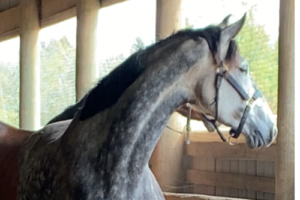
.
By situating my body sideways to her I could still know where she was in the stall, but it was important to make sure I was not directly facing her. Again, this was for her to feel comfortable and not feel like she was my prey.
The first goal was for her to relax and allow her curious side to take over. By not approaching her it allowed her to think about the situation and gradually she came to me. She was jumpy and nervous, reaching out her nose to me and then withdrawing, so remaining still and not reacting was key at this point.
The second goal was to wait for her to invite me to give her a little rub on her shoulder. A trainer needs to wait and be sure the horse is going to be accepting of the connection especially as these are going to be important moments in your interaction.
Patience is your friend and rushing is your enemy when training horses.
After a few minutes she went from being nervous and jumpy to searching for the treats she could smell. Rewarding this curiosity with treats will provide building blocks of communication between you.
After a few minutes, ALL ON HER TIME SCALE OF ACCEPTANCE NOT MINE, I let her smell the halter and when she was ready I gently put it on and led her out to her new paddock for the day.
How to overcome Jazz’s fear of being caught in the paddock!
Getting her outside was only a part of the problem! At the end of the day it was time to catch her and bring her back into her stall as a part of the process of getting her used to her new routine in life.
The first few days she was in a paddock alone so she could get used to her new environment and meet her new paddock mate over the fence. After a few days of getting used to each other they would be paddocked together.
At the end of the first day it was time to catch her and bring her in. There would be no point in attempting to chase her and catch her. I needed to make her WANT to be caught and come in, it needed to be HER IDEA.
The first step was to bring all the other horses into the barn so that the herd was gone, her attention would be on where they went, and her desire would be focused on wanting to follow them.
Using the same approach as catching her in the stall was the key. Entering the paddock with halter, rope, and treats in my pocket, I turned my eyes away from her, body sideways and waited for her to come to me.
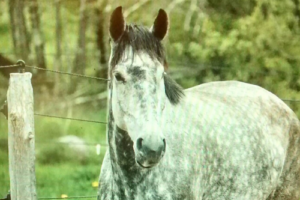
.
She was still jumpy and nervous but waiting for her and not rushing the process won her over. I would occasionally step sideways towards her to scratch her shoulder, keeping my body turned away from her and eyes down.
If she moved away I waited for her to come back and search for treats and waited for her to she show me she was ready to put the halter on.
I would ‘offer’ her the halter so she could see it and sniff it, but I didn’t attempt to put it on her until I knew she was ready. It was HER DECISION to be caught at which point she received her treat and we walked back to the barn.
AN IMPORTANT NOTE – ACHIEVING SUCCESS IN THIS WAS ABOUT HAVING NO TIME LIMITS AND ABOUT ACCEPTING THE PEACE IN THE PROCESS OF BONDING NO MATTER HOW LONG IT TAKES.
This process was repeated every day for a few weeks. Eventually my staff could catch her in the stall easily enough but continued to have issues catching her in the paddock and called on me to catch her for quite some time. She always came and haltered right away and they could never understand why as they tried the same methods I used.
My theory as to why she wouldn’t allow them to catch her for a few weeks when she was in the paddock was “the lack of patience and wait theory”.
What does that mean? Let me explain…
My staff were hard working, horse loving young women. They had a job to do and at the end of the day it was to bring in the horses and care for them. They would go to catch her and follow the same steps they had seen me perform but she would not let them halter her.
At first I also wondered why they couldn't catch her given they were following the same methods. That is when I figured out is was the “lack of patience and wait”.
They FELT they were being patient and waiting for her. The BELIEVED they were being patient and waiting for her and in fairness to them, they WERE being patient and waiting for her… but not in the way that was needed.
Any sense of urgency in the staff wanting to catch her would transmit to her and she would withdraw. In an way you have to be in a kind of ZEN place when working with a nervous horse.
Horses rely on their senses to survive in the wild and we need to take this into account when we work on them.
For them to bond and trust us they must feel we are a strong and safe place to be. We must be both their herd leader, and their sanctuary. They need to trust we will lead them to their needs. They need to want to follow us.
When you are training your horse you need to do so by helping them to make the decision to WANT to follow you. Once THEY want to follow you, they will always follow you.
Overview
- Your horse has a flight of flight response.
- You are the predator and they are the prey.
- Approach training your horse in order to avoid the flight or fight response, and the feeling they are your prey.
- Encourage their curiosity in order to start bonding.
- Let them make good decisions instead of forcing them.
- True patience and waiting for them is key to success.
My next blog about Jazz will be about “How to Stop the Rearing!”
This post may contain affiliate links. Please read our disclosure for more info.
admin
Latest posts by admin (see all)
- A Horse For All Reasons – Guest Blog by Lucy from Horse Factbook - April 8, 2020
- How To Deal With A Spooky Horse Trail Riding - March 31, 2020
- Our Top 20 Amazon Equestrian Products - January 30, 2020





